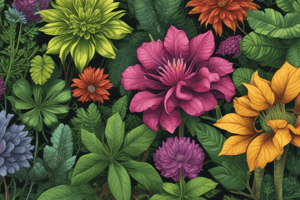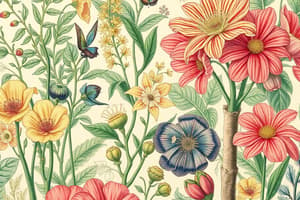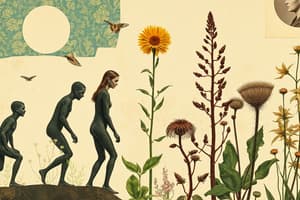Podcast
Questions and Answers
Which of the following is NOT a major adaptation that allowed plants to thrive on land?
Which of the following is NOT a major adaptation that allowed plants to thrive on land?
- Development of structures for protection against drying out.
- Development of stems and leaves for support and photosynthesis.
- Development of chloroplasts for photosynthesis. (correct)
- Development of a vascular system for transport of water and nutrients.
What is the main limitation of non-vascular plants compared to vascular plants?
What is the main limitation of non-vascular plants compared to vascular plants?
- Non-vascular plants cannot perform photosynthesis effectively.
- Non-vascular plant reproduction requires seeds, limiting dispersal.
- Non-vascular plants lack specialized transport vessels, restricting their size and habitat. (correct)
- Non-vascular plants cannot respond to environmental stimuli.
How does seed development provide an advantage for plants in terrestrial environments?
How does seed development provide an advantage for plants in terrestrial environments?
- Seeds enhance the rate of photosynthesis in the developing plant.
- Seeds require water for fertilization, increasing reproductive success.
- Seeds protect the embryo and provide a food supply, aiding in dispersal and survival. (correct)
- Seeds allow plants to reproduce asexually, leading to rapid population growth.
What is the key distinction between gymnosperms and angiosperms?
What is the key distinction between gymnosperms and angiosperms?
In angiosperms, what is the direct result of pollen fertilizing the ovary?
In angiosperms, what is the direct result of pollen fertilizing the ovary?
Which of these characteristics is typically used to differentiate between monocots and dicots?
Which of these characteristics is typically used to differentiate between monocots and dicots?
Consider a plant wilting from a lack of water. Which specific vascular tissue is most directly affected and responsible for this condition?
Consider a plant wilting from a lack of water. Which specific vascular tissue is most directly affected and responsible for this condition?
Xylem is composed of dead cells called tracheids. What functional advantage does this provide to the plant?
Xylem is composed of dead cells called tracheids. What functional advantage does this provide to the plant?
Which of the following is the primary mechanism by which water initially enters the xylem in plant roots?
Which of the following is the primary mechanism by which water initially enters the xylem in plant roots?
What is the primary function of the root cap in plant roots?
What is the primary function of the root cap in plant roots?
Which adaptation of leaves is most beneficial for plants in arid environments?
Which adaptation of leaves is most beneficial for plants in arid environments?
How do the functions of xylem and phloem contribute to the overall survival and growth of a plant?
How do the functions of xylem and phloem contribute to the overall survival and growth of a plant?
In which part of the leaf does most of the photosynthesis occur?
In which part of the leaf does most of the photosynthesis occur?
What is the role of stomata in leaves, and how is this role regulated?
What is the role of stomata in leaves, and how is this role regulated?
How do the leaves of deciduous trees differ structurally from those of coniferous trees, and what are the implications of these differences?
How do the leaves of deciduous trees differ structurally from those of coniferous trees, and what are the implications of these differences?
Which of the following characteristics is typically associated with monocots?
Which of the following characteristics is typically associated with monocots?
What is the role of rhizomes and stolons in plant propagation?
What is the role of rhizomes and stolons in plant propagation?
How does translocation differ from transpiration in plants?
How does translocation differ from transpiration in plants?
Flashcards
Plants
Plants
Multicellular eukaryotes with chloroplasts for photosynthesis, fixed in place, with cellulose-based cell walls.
Plant Adaptations to Land
Plant Adaptations to Land
Protection from drying out, vascular systems for transport, and stems/leaves for support and photosynthesis.
Non-vascular Plants
Non-vascular Plants
Plants lacking vessels for transporting nutrients, water, or waste, needing moisture for reproduction, and making spores instead of seeds.
Ferns
Ferns
Signup and view all the flashcards
Seeds
Seeds
Signup and view all the flashcards
Gymnosperms
Gymnosperms
Signup and view all the flashcards
Angiosperms
Angiosperms
Signup and view all the flashcards
Xylem
Xylem
Signup and view all the flashcards
Osmosis in Roots
Osmosis in Roots
Signup and view all the flashcards
Transpiration
Transpiration
Signup and view all the flashcards
Translocation
Translocation
Signup and view all the flashcards
Monocot Roots
Monocot Roots
Signup and view all the flashcards
Dicot Roots
Dicot Roots
Signup and view all the flashcards
Root Structure Zones
Root Structure Zones
Signup and view all the flashcards
Root Hairs
Root Hairs
Signup and view all the flashcards
Cuticle (Leaf)
Cuticle (Leaf)
Signup and view all the flashcards
Epidermis (Leaf)
Epidermis (Leaf)
Signup and view all the flashcards
Palisade Cells
Palisade Cells
Signup and view all the flashcards
Study Notes
- Plants are multicellular eukaryotes containing chloroplasts for photosynthesis.
- They are non-motile, fixed in one spot, and have cell walls made of cellulose.
- Plants respond to their environment.
- The first plants lived in water.
Major Adaptations to Land
- Protection from drying out for leaves and stems.
- A vascular system transports water, nutrients, and wastes.
- Stems and leaves provide support and facilitate photosynthesis.
Non-Vascular Plants
- Lack a vascular system for transporting nutrients, water, or waste.
- The earliest land plants were non-vascular.
- Reproduction requires a moist surface for gametes to swim.
- Produce spores, not seeds.
- Substances move via osmosis and diffusion, limiting growth.
Vascular Plants
- Ferns were the first vascular plants.
- Have vascular tissue for material transport, enabling taller growth.
- True roots anchor the plant and absorb water and minerals.
- Leaves are photosynthetic and absorb gases.
- Still reproduce using spores.
Plants with Seeds
- Seeds allow sexual reproduction without water for gamete transfer.
- Seeds contain an embryo, food supply, and waterproof coat.
- Gymnosperms produce "naked seeds' such as pine cones.
- Angiosperms are flowering plants with seeds protected in fruit, attracting animals for seed dispersal.
Monocots and Dicots
- Two classes of angiosperms, differing in seed leaf number.
- Monocots have one seed leaf, dicots have two.
- Angiosperms share plant parts but differ in organization, affecting root, stem, and leaf structure.
- Roots and stems differ due to vascular bundle patterns.
Vascular Bundles
- Xylem and phloem are the two vessel types in vascular bundles.
- Xylem carries water and minerals from roots to stems, leaves, and flowers.
- Phloem carries sugars between plant cells.
Xylem
- Xylem transports water and is formed from dead tracheid cells.
- Water enters roots from the soil through osmosis.
- Water evaporates from leaves through transpiration.
Phloem
- Phloem is formed from living sieve tube elements.
- Sugar dissolved in water moves up and down the plant via translocation.
Monocot Characteristics
- Fibrous, networked roots.
- One seed leaf.
- Scattered vascular tissue.
- Parallel leaf veins.
- Flower parts in multiples of three.
Dicot Characteristics
- Taproots, like dandelions.
- Two seed leaves.
- Vascular tissue in an outer ring.
- Network of leaf veins.
- Flower petals in multiples of four or five.
Root Functions
- Anchor the plant.
- Absorb water and minerals.
- Protect the soil from erosion.
- Transport water through xylem.
Root Structure: Zones
- Zone of maturation: cells differentiate into specialized types.
- Zone of elongation: promotes deeper root penetration.
- Meristematic region: rapid mitosis of undifferentiated cells.
- Root cap: protects the meristematic region.
Water and Nutrient Absorption
- Root hairs extend from the epidermis, increasing surface area.
- Water enters from the soil by osmosis, flowing through the xylem.
- Nutrients like nitrates, phosphates, potassium, and magnesium dissolve in water and enter the roots.
Stems
- Annual plants have green stems, growing from seeds yearly.
- Perennial plants have woody stems, like trees and shrubs
Stem Functions
- Support leaves for light exposure.
- Transport water and minerals via xylem.
- Transport sugar via phloem.
- Specialized functions: Stolons (strawberries) for asexual reproduction; Rhizomes (irises) with underground stem buds for asexual reproduction; Tubers (potatoes) for starch storage.
Leaf Functions
- Trap light for photosynthesis, producing glucose.
- Exchange gases (CO2 and O2).
- Water loss by transpiration aids water uptake from roots.
- Provide food, shade, habitat, and oxygen for organisms.
Deciduous vs. Needles
- Deciduous leaves are wide, capturing more light, and flat, increasing surface area for gas exchange.
- Needles have a thick, waxy coating to save water, can photosynthesize all year, have low wind resistance, and survive ice and snow.
Leaf Structure
- Cuticle: A waxy layer that protects the leaf and reduces water and gas loss.
- Epidermis: Provides support, is transparent for sunlight, the lower epidermis has stomata and guard cells.
- Palisade cells: Located under the upper epidermis, contains chloroplasts, is the site of photosynthesis.
Stomata
- Found on the leaf's underside, opening and closing according to CO2 needs for photosynthesis and water conservation.
- Designed for gas exchange (CO2 in, O2 out).
Spongy Mesophyll
- Loosely packed cells near the leaf's bottom with large air spaces for gas diffusion.
- Water vapor moves into these spaces and exits through stomata via transpiration.
Vascular Bundles
- Xylem and phloem are found in leaf veins.
- Xylem carries water and minerals to cells, and phloem carries glucose to other plant cells.
Studying That Suits You
Use AI to generate personalized quizzes and flashcards to suit your learning preferences.




